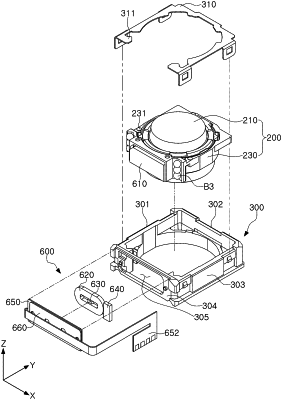| CPC G03B 5/04 (2013.01) [G02B 27/646 (2013.01); G03B 13/34 (2013.01); G03B 2205/0015 (2013.01); G03B 2205/0069 (2013.01)] | 18 Claims |

|
1. A camera module comprising:
a lens holder accommodating a lens module therein;
a housing accommodating the lens module and the lens holder therein;
a shake correction unit comprising first and second magnets, disposed in the lens holder, and first and second coils disposed to face the first and second magnets;
a focusing unit comprising a third magnet, disposed in the lens module, and a third coil disposed on a first substrate disposed on the lens holder; and
a plurality of ball members configured to support movement of the lens module in a direction perpendicular to an optical axis,
wherein the lens module, the lens holder, the third magnet, and the third coil are moved together in the direction perpendicular to the optical axis, by driving force of the shake correction unit,
wherein the first substrate comprises a body portion, provided with the third coil, and an extension portion bent to extend from the body portion,
wherein the extension portion comprises a first extension portion, bent about a direction parallel to the optical axis direction to extend from one side of the body portion to be spaced apart from the body portion, and a second extension portion bent about another direction parallel to the optical axis direction to extend from the first extension portion, which is perpendicular to the first extension portion.
|